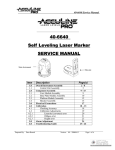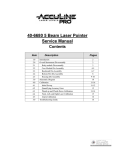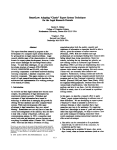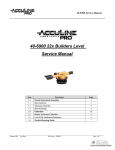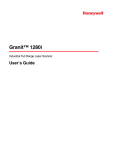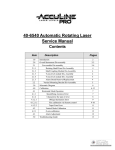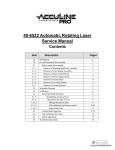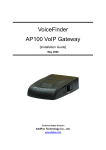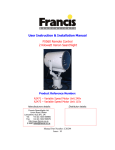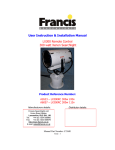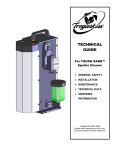Download 40-6532/40-6543 Auto-leveling Rotating Laser Service Manual
Transcript
40-6532/40-6543 Auto-leveling Rotating Laser Service Manual Item Description Pages 1.0 Overall Instrument Assembly 1.1 Main Housing Assembly 2-3 1.2 Upper Housing Assembly 3-4 1.3 Core Part Assembly 4-5 1.3.1 Main Axis Assembly 5 1.3.2 Top Bracket Assembly 6 1.3.4 Bottom Bracket Assembly 7 1.4 Base assembly 8 2.0 Calibration 2.1 Horizontal Mode Operation 2.1.1 Quantifying Accuracy Error 9 2.1.2 Characterize the type of error 10 2.1.2.1 Oblique Error 11 2.1.2.2 Taper Error Wave Error 12 Vertical Mode Operation 14 Vial Calibration 14 2.3 Leveling Range Alarm Calibration 14 3.0 Circuit Board Connections 15 4.0 Troubleshooting Guide 16 2.1.2.3 2.2 2.2.1 2 8-15 9 13 40-6532/40-6543 Service Manual 1. Overall Instrument Assembly This rotating laser is a highly accurate instrument. Out side of a few customer adjustments (outlined in the owners manual), all adjustments/service operations are internal to the instrument and to be performed only by authorized service personnel. Authorized personnel should adhere to the guidelines described within this service manual for all repairs and/or service work. This service manual specifically discusses two very similar products; 40-6532 40-6543 Physical construction and components of the two products are identical. The main difference is the laser diode used for each product (40-6543 green vs. 40-6532 red). 1.1 Main Housing Assembly (40-6543) Item JLT Part # 1 AP1449 M2.5 x 6 Cross-Slot Plate Screw 4 2 AP1879 Bracket Plate 1 3 AP1880 Pivot Screw 2 4 AP1881 Upper Housing Assembly 1 5 AP1513 M3 x 8 Cross-Slot Plate Screw 11 6 AP1883 3mm Elastic Gasket 6 7 AP1884 Core Part Assembly 1 8 AP1885 Press Board 1 1 9 AP1886 Pin 1 10 AP1887 Base Assembly 1 11 AP1493 M2.5 x 8 Cross-Slot Plate Screw 1 12 AP1888 On/Off Switch 1 13 AP1889 Sealed Ring 1 1 14 AP1890 Battery Housing 1 Prepared By: Tim Wojo Description Revision: 2-042109 Qty Page 2 of 16 40-6532/40-6543 Service Manual 1. Remove battery housing (14) by loosening the flat head retaining screw. 2. Remove ON/OFF switch (12) by first removing retaining screw (11). Once retaining screw (11) has been removed, ON/OFF switch (12) and sealing ring 1 (13) can be removed. 3. Remove Bracket plate (2) by removing 2 pivot screws (3). The bottom portion of the bracket plate is held in place by the Press board 1 (8), 4 retaining screws (1) and retaining pin (9). Loosen the 4 retaining screws (1) to remove press board (8) and slide retaining pin (9) out to remove bracket plate (2) 4. Now that bracket plate (2), battery housing (14), and ON/OFF switch (12) have been removed the upper housing assembly (4) can be removed. Remove this by loosening the 5 retaining screws (5) located at the base of the unit. As the upper housing assembly is being removed, note that there are wires that make the electrical connections between the upper housing and the core module. These wires can break and caution should be taken as the two parts are being separated. 5. Remove the Core module assembly (7) from the Base Assembly (10) by removing the 6 retaining screws (5) and their 6 elastic gaskets (6) 1.2 Upper Housing Assembly (AP1881) Item JLT Part # Description Qty 4-1 AP1891 Top Cover Assembly 1 4-2 AP1892 Window 1 4-3 AP1893 Housing 1 4-4 AP1558 ST2.9 x 9.5 Cross-Slot Tapping 4 Screw 4-5 AP1894 8# Remote Control Receiving PCB 1 4-6 AP1843 ST2.2 x 6.5 Cross-Slot Plate 4 Tapping Screw 4-7 AP1538 2.5mm Nut 8 4-9 AP1895 1# Key Pad PCB 1 4-10 AP1896 Key Pad Membrane 1 4-11 AP1897 M2.5 x 10 Cross Sunk Screw 4 4-7 Prepared By: Tim Wojo Revision: 2-042109 Page 3 of 16 40-6532/40-6543 Service Manual 1. The key pad assembly (4-9) can be removed by disconnecting electrical wires from the remote control receiving PCB (4-5). Remove the 4 retaining nuts (4-7) from the retaining screws (4-11) and remove key pad assembly (4-9) from housing (4-3). The retaining screws can be removed by peeling back the key pad membrane (4-10) and removing the 4 retainer nuts (4-8). 2. Remove the remote control receiver PCB (4-5) by removing its 4 retaining screws (4-6). 3. Remove the top cover ((4-1) and window (4-2) by removing the 4 retaining screws located on the under side of the housing (4-3). 1.3 Core Part Assembly (AP1884) Item JLT Part # Description Qty 7-1 AP1647 M2 x 5 Cross-Slot Plate Screw 6 7-2 AP1898 Rotary Head Assembly 1 7-3 AP1899 Prism Base Part 1 7-4 AP1843 ST2.2 x 6.5 Cross-Slot Plate 4 Tapping Screw 7-5 AP1900 #3 Hairspring Switchover PCB 1 7-6 AP1572 M2.5 x 10 Cross-Slot Plate Screw 4 7-7 AP1902 Main Axis Assembly 1 7-8 AP1903 #4 Hairspring Switchover PCB 1 7-9 AP1493 M2.5 x 8 Cross-Slot Plate Screw 5 7-10 AP1511 M3 x 12 Cross-Slot Plate Screw 4 7-11 AP1904 Press Board 2 1 7-12 AP1582 2.5mm Flat Washer 2 7-13 AP1616 M2.5 x 5 Cross-Slot Plate Screw 3 7-14 AP1877 Top Bracket Assembly 1 7-15 AP1878 Bottom Bracket Assembly 1 7-16 AP1905 Front Semi-Circle Piece 1 7-17 AP1906 #6 Sensitive Switch PCB 1 7-18 AP1513 M3 x 8 Cross-Slot Plate Screw 1 7-19 AP1883 3mm Elastic Gasket 4 7-20 AP1907 Bracket 1 7-21 AP1908 M3 x 4 Allen Head Tightening 1 Screw Prepared By: Tim Wojo Revision: 2-042109 Page 4 of 16 40-6532/40-6543 Service Manual 1. Remove the rotary head assembly (7-2) from the prism base part (7-3) by removing 2 retaining screws (7-1). 2. Remove the prism base part (7-3) from the main axis assembly (7-7) by loosening Allen Notched Tightening Screw (7-21). 3. Remove Hair spring switch over PCB #3 (7-5) from Hair spring switch over PCB #4 by de-soldering hair springs (not shown) and removing 4 retaining screws (7-4). 4. Remove Bracket (7-20) from top bracket assembly (7-14) by removing 3 retaining screws (7-9). 5. Remove 4# Hairspring Switchover PCB (7-8) from top bracket assembly (7-14) by removing 4 retaining screws (7-1). 6. Remove Switch PCB (7-17) from bottom bracket assembly (7-15) by removing its 2 retaining screws (7-18 and 7-13 respectively). 7. Remove top bracket assembly (7-14) from lower bracket assembly (7-15) by removing 4 retaining screws (7-10) and their respective elastic gaskets (7-19),and 2 retaining screws (7-9) from front semi circle piece (7-16). 8. Remove Press board #2 (7-11) from top bracket assembly (7-14) by removing 2 retaining screws (7-13) and their respective flat washers (7-12). 9. Remove main axis assembly (7-7) from top bracket assembly by removing 4 retaining screws (7-6). 1.3.1 Main Axis Assembly (AP1902) Item JLT Part # Description Qty 7-7-1 AP1838 M2 x 4 Cross-Slot Plate Screw 3 7-7-2 AP1909 Progressive Motor 1 7-7-3 AP1910 Main Axis 1 7-7-4 AP1911 Laser Source Part 1 7-7-5 AP1491 M2 x 8 Cross-Slot Plate Screw 4 1. Remove laser source part (7-7-4) from main axis (7-7-3) by removing 4 retaining screws (7-7-5). 2. Remove the progressive motor (7-7-2) from main axis (7-7-3) by removing 3 retaining screws (7-7-1) Prepared By: Tim Wojo Revision: 2-042109 Page 5 of 16 40-6532/40-6543 Service Manual 1.3.2 Top Bracket Assembly (AP1877) Item JLT Part # Description Qty 7-14-1 AP1912 Adjustment Base 1 7-14-2 AP1913 Gimbal Part 1 7-14-3 AP1914 Top Bracket 1 7-14-4 AP1915 2.5mm Elastic Gasket 3 7-14-5 AP1513 M3 x 8 Cross-Slot Plate Screw 3 7-14-6 AP1916 Gimbal Mount 1 7-14-7 AP1883 3mm Elastic Gaskets 3 7-14-8 AP1530 M3 x 25 Cross-Slot Plate Screw 3 7-14-9 AP1917 Pendulum Parts 1 7-14-10 AP1908 M3 x 4 Allen Head Tightening 1 Screw 7-14-11 AP1918 M2.5 x 25 Cross-Slot Plate Screw 4 7-14-12 AP1022 M3 x 6 Cross-Slot Plate Screw 2 7-14-13 AP1919 #5 Alarm PCB 1 7-14-14 AP1920 Vial Assembly 1 1. Remove Vial Assembly (7-7-14) from Base Part (7-14-6) by loosening 4 retaining screws (7-14-11). 2. Remove Alarm PCB (7-14-13) by loosening 2 retaining screws (7-14-12). Note that wires running to the alarm PCB will need to be de-soldered before it can be removed 3. Remove Pendulum part (7-14-9) by loosening Allen head tightening screw, then rotating the Pendulum part (7-14-9) counterclockwise to un screw it from the Base part (7-14-6) 4. Remove Base part (7-14-6) and Adjustment Base (7-14-1) from Gimbal part (7-14-2) from loosening 3 retaining screws (7-14-8). 5. Note that retaining screws have elastic gaskets on them (7-14-7) Remove Gimbal part (7-14-2) from Top bracket (7-14-3) by loosening 3 retaining screws (7-14-5). Note that retaining screws have elastic gaskets on them (7-14-4) Prepared By: Tim Wojo Revision: 2-042109 Page 6 of 16 40-6532/40-6543 Service Manual 1.3.3 Bottom Bracket Assembly (AP1878) 1. Item JLT Part # Description Qty 7-15-1 AP1513 M3 x 8 Cross-Slot Plate Screw 5 7-15-2 AP1883 3mm Elastic Gasket 5 7-15-3 AP1921 Connecting Board 1 7-15-4 AP1922 Compression Spring 2 7-15-5 AP1923 Back Semi-circle Press piece 1 7-15-6 AP1449 M2.5 x 6 Cross-Slot Plate Screw 3 7-15-7 AP1582 2.5mm flat washer 3 7-15-8 AP1924 Shield Ring 1 7-15-9 AP1925 Bottom Bracket 1 7-15-10 AP1926 Crankshaft 1 7-15-11 AP1927 Magnetic Base Part 1 7-15-12 AP1915 2.5mm Elastic Gasket 4 7-15-13 AP1616 M2.5 x 5 Cross-Slot Plate Screw 6 7-15-14 AP1928 Connecting Column 2 7-15-16 AP1516 3mm flat washer 2 7-15-17 AP1929 #7 Alarm Spring PCB 1 7-15-13 Remove Connecting board (7-15-3), Compression springs (7-15-4), Back semi-circle Press Piece (7-15-5), and Crank shaft (7-15-10) by loosening 3 retaining screws (7-15-1). Note that retaining screws have elastic gaskets on them (7-15-2). 2. Remove Alarm Spring PCB (7-15-17) from Connecting board (7-15-3) by loosening 2 retaining screws (7-15-15). Note that retaining screws have elastic gaskets on them (7-15-16). 3. Remove magnetic Base part (7-15-11) from Bottom bracket (7-15-9) by loosening 4 retaining screws (7-15-13). Note that retaining screws have elastic gaskets on them (7-15-12). 4. Remove Connecting Columns (7-15-14) from Bottom Bracket (7-15-9) by loosening retaining screw (7-15-1). Note that retaining screws have elastic gaskets on them (7-15-2). 5. Remove Shield Ring (7-15-8) from Bottom Bracket (7-15-9) by loosening 3 retaining screw3 (7-15-6). Note that retaining screws have elastic gaskets on them (7-15-7). Prepared By: Tim Wojo Revision: 2-042109 Page 7 of 16 40-6532/40-6543 Service Manual 1.4 Base Assembly (AP1887) Item JLT Part # Description Qty 10-1 AP1930 Connecting Column 2 1 10-2 AP1843 ST2.2 x 6.5 Cross-Slot Plate 2 Tapping Screw 10-3 AP1931 Buzzer 1 10-4 AP1932 #2 Switch Part 1 10-5 AP1933 Base 1 10-6 AP1493 M2.5 x 8 Cross-Slot Plate Screw 1 10-7 AP1934 Hand Wheel 2 1 10-8 AP1935 Sealed Ring 1 10-9 AP1936 Screw Bolt 1 10-10 AP1937 Slipper Block 1 10-11 AP1938 5mm “E” Ring 1 1. Buzzer (10-3) is epoxied in place Base (10-5) and should not be removed 2. Remove Horizontal/Vertical Switch part (10-4) from Base (10-5) by loosening 2 retaining screws (10-2). Note that Buzzer (10-3) wires need to be de-soldered before switch can be removed. 3. Remove connecting column (10-1) from Slipper Block (10-10) by removing e-ring (10-11). 4. Remove Slipper Block (10-10) from Base (10-4) by removing Hand wheel (10-7. Hand wheel (10-7) is removed by loosening retaining screw (10-6). 5. Remove Screw Bolt (10-9 from Slipper Block (10-10) by rotating it counterclockwise until it comes off. 2.0 Calibration Calibration is a process that is used to correct for accuracy and/or functional errors above and beyond those stated in published specifications. While Manual-leveling, Self-leveling, and Automatic-leveling (motor driven) devices have different mechanisms that require calibration, there are similarities with optics that is consistent regardless of the leveling mechanism. This section of the service manual discusses calibrations specific to the 40-6532/40-6543. Each item discussed is shown below. 2.1 Horizontal Mode Operation 2.1.1 Quantifying Accuracy Error 2.1.2 Characterize the type of error 2.1.2.1 Oblique Error 2.1.2.2 Taper Error 2.1.2.3 Wave Error 2.2 Vertical Mode Operation 2.2.1 Vial Calibration 2.3 Leveling Range Alarm Calibration Prepared By: Tim Wojo Revision: 2-042109 Page 8 of 16 40-6532/40-6543 Service Manual 2.1. Horizontal Mode Operation In this mode of operation, the instrument is self-leveling, where by a major factor of accuracy is how well the leveling compensator is balanced. Different types of errors require different methods of calibration. These errors are easily characterized by placing the instrument on a flat surface following the guidelines below, and running the instrument with the rotating head continuously rotating 360°. 2.1.1. Quantifying Accuracy Error Establish the test set-up shown in the following illustration and confirm that it meets the following requirements: 1) The debugging platform should be horizontal with a error less than 0.1°(6′); 2) The distance L from the center of the debugging clamp to the wall should be L≥10m; 3) The accuracy of the reference marking is no less than 0.05mm/m; 4) The adjacent-light ruler should be put within 0.3m (12”) of the instrument (the zero position of the ruler should be located at the same height as that of the laser line at the emitting hole). Far Target placed on wall at least 10m (33ft) from Test Stand, where “0” corresponds to them same height as “0” on the target next to the aperature of the instrument. Laser line Instrument for test (laser spinning 360° rotation) 0 Reference Line (Known Height) Distance (L) >10m (33ft) Target 0 Accuracy (A) = Difference between laser line height and reference line height, divided by the distance that the laser is from the wall (L) Flat Surface (Test Stand) Near Target placed within 0.3m (12”) of instrument. Note that “0” of the target corresponds to the height of laser line at the aperature of the instrument. 1. Place the instrument for test on the test stand (preconfigured from the illustration above) with handle facing the far target . 2. Power the laser and function in full rotation mode (head rotates 360°) 3. Note the errors in all four quadrants of the instrument as read on the far target (i.e. x axis A = 0° and B = 180°, y axis C = 90° and 270°) You should end up with 4 numbers i. A (0°) = _____ ii. B (180°) = ______ iii. C (90°) = ______ iv. D (270°) = ______ 4. Since all of the errors are referenced against “0” on the far target, essentially the largest number from the data collected (A – D) / the distance should be equal to or less than the published specification for the product. If not, characterize the error and determine method of calibration as defined by section 4.1.2 of this document. Prepared By: Tim Wojo Revision: 2-042109 Page 9 of 16 40-6532/40-6543 Service Manual 2.1.2. Characterize the type of error Use the following rules to determine what to of accuracy error the instrument for test has, and reference the stated section to adjust for it. Note that the unit my have a combination of different types of errors to adjust for, in which case, multiple calibration must be performed. Accuracy is beyond Accuracy meets published published specification specification Yes 1 Yes A=0 & B=0 C=0 & D=0 No No Yes A and B <> 0 but Section 2.1.2.1 Yes Oblique Error A+B=0 C and D <> 0 but C+D=0 No No Yes A and B <> 0 but Section 2.1.2.2 Yes C and D <> 0 but Taper Error A= B C=D No No Yes A and B <> 0 and Section 2.1.2.1 Yes C and D <> 0 and Oblique Error A + B <> 0 C + D <> 0 No No Section 2.1.2.2 Taper Error 1 Prepared By: Tim Wojo No Yes A = B <>C=D Section 2.1.2.3 Wave Error Revision: 2-042109 Page 10 of 16 40-6532/40-6543 Service Manual 2.1.2.1. Oblique error This type of error occurs when leveling compensator does not hang straight (as illustrated to the right), i.e. is not properly balanced. When the laser spins, it actually rotates on a plain that is not level, i.e. perfectly horizontal whose rotating axis is not plumb. So value A on the left target does not has the same sign as that on the right target, like, A0°=+2, A180°= -2. A number of factors can cause this situation to exist. Normal use – Depending upon how careful the user is with the instrument, finely tuned adjustments can be altered by very large changes in temperature, vibrations (due to handling and transportation) Shock – The instrument was dropped and components of the leveling system (gimbal, compensator weight and shaft., screw adjustments) have either been damaged or came out of alignment. If defective components are present, they will need to be repaired or replaced prior to the calibration procedures defined below being initiated. Depending upon the magnitude of the error (±5mm or 0.2”), only fine adjustments need to be made. 0.2”) require coarse adjustment to get close, the fine adjustment to bring the unit within specification. Larger errors (>5mm or Both adjustments are defined below With the instrument on the measuring platform describe in section 2.1.1, remove the battery box and remove off plastic screws. Remove rubber plug to expose the calibration adjustment. Calibration screws are adjusted with a flat head screw driver. Clockwise rotation shifts the weight on the compensator to the opposite side of the adjustment screw causing the laser line to drop. Conversely, counterclockwise rotation shifts the weight on the compensator to the near side of the adjustment screw causing the laser line to rise. If the error is too large to calibrate through the self-calibration apertures, coarse calibration is required. Remove housing (reference section 1.1) to expose the 4 inner calibration adjustments (right). Using a Phillips screwdriver, adjust the instrument accuracy by systematically loosening/tightening the adjustments in a alternating fashion (i.e. if one adjustment is loosened, the adjustment to the opposite side of it needs to be tightened by the same amount). X/Y orientation of housing determines X/Y adjustments within the unit. After adjustments have been completed loc-tight all 4 adjustments to prevent them from moving through temperature cycling, vibration, normal use, etc. Prepared By: Tim Wojo Revision: 2-042109 Page 11 of 16 40-6532/40-6543 Service Manual 2.1.2.2 Taper Error Taper error results when the prism base module (discussed in section 1.3, item 7.2) does not reflect the laser light exactly 90° (i.e. non-perpendicularity between the rotating line and the rotating axis). The end result is a laser rotating surface that is not a plane, but a tapered one as shown in the figure to the right. Taper error The value A in the left target shares the same symbol as the one in the right target during the check, that is, A0°=+2 and A180°= +2. The error is removed by adjusting the optical wedge of the laser output window to make the rotating laser beam and rotating axis plumb beam. The details are listed as follows: a. Remove the top cover as discussed in section 1 of this document b. Screw the wedge out of its base with special spanner as shown in the figure Optical wedge to the right. c. Adjust the laser to the zero position of the target. d. Loc-tight adjust after it has been set. Note: Only one direction (X or Y) is necessary for the adjustment. Prepared By: Tim Wojo Revision: 2-042109 Page 12 of 16 40-6532/40-6543 Service Manual 2.1.2.3 Wave Error This error occurs when the rotating laser surface is not a plane, but a turn up one as shown in the figure to the right. The rotating beam projected on the wall is crooked, similar to waviness, which is caused by the unbalance of rotating head. The value A Wave error checked in the X-direction deviates upwards while the one in the Y-direction downwards, or the value A in the Y-direction upwards while the one in the X-direction downwards. Meanwhile, you can see the laser point above the head is mobile and its orbit is inclined to be a circle. The error can be removed by adjusting the balance block of the Rotating head as follows: a. Remove the top cover as discussed in section 1 of this document. b. Regulate the adjusting screws on the four balance block as shown in the figure to the right, until the laser point above the head becomes stable, namely, the laser point projected on the ceiling being a stable one. 1) As shown in the figure below, put the table vice on the debugging platform; 2) Fix the core part on the adjustment fixture, and Install the adjustment fixture on the table vice, to make the laser spot towards the wall; 3) Turn the core part, to make the laser revolve around the rotary axis. Adjust the 4pcs of adjustment crews which are used for fixing the laser indicator, in order to make the diameter of the laser spot circle no more than 1.25cm; 4) Spread the screw and laser source part with shellac; Prepared By: Tim Wojo Revision: 2-042109 Page 13 of 16 40-6532/40-6543 Service Manual 2.2. Vertical Mode Operation In this mode of operation, the rotating laser surface is a plumb plane, while the laser line projected from the top is in projecting horizontal. While in this mode, the instrument is manually level, meaning that accuracy is a function of how accurately the vial is calibrated. 2.2.1 Vial Calibration Vial accuracy/calibration is accomplished by performing the following: a. Place the laser level on it’s side (mounting trivot) on the test stand described in section 2.1.1. The test stand is referenced throughout this procedure. b. Adjust the leveling screw (located directly below the keypad assembly) until the vial indicates “level” i.e. bubble is directly in the center of the vial. c. Measure the difference between the near target and far target. Given this test set up, the error should be 1mm or less. Anything greater, requires calibration procedure that follows: d. Remove the Upper housing assembly as shown in section 1.1. e. Attach unit to special mounting platform. f. Turn unit on and adjust the height of the laser dot such that it is at the same height on the near and far targets (disregard reading of vial at the point. g. Now that the laser dot is shooting the same height on both the near and far targets, adjust the 4 adjustment screws (shown above) until the bubble in the center of the vial. 2.3. Alarm Calibration The alarm function is made up of 3 components, the 2 alarm PCB’s (7-15-17, 7-14-13) and the buzzer (10-3). Calibrating it is a matter of centering the contact ring of 7-14-13 to the spring post of 7-15-17. When the spring post makes contact with the contact ring of 7-14-13, the buzzer (10-3) sounds. Centering the post between the ring offers equal angular alarming in all directions. Adjustments are made as follows: a. Remove the Upper housing assembly as shown in section 1.1. b. Locate the adjustment screws 7-14-12 (reference section 1.3.2). c. Loosen the adjustment screws and manually center the contact ring of 7-14-13 to the spring post of 7-15-7. d. Tighten the adjustment screws and reassemble the upper housing assembly to the base assembly. Prepared By: Tim Wojo Revision: 2-042109 Page 14 of 16 40-6532/40-6543 Service Manual 3.0 Circuit Board Connection 1 3 8# 1# 5# 7# 4# 1 8 1 2 1 4 1 3 6# 3# 2# Figure 20 Electric Connection Drawing Prepared By: Tim Wojo Revision: 2-042109 Page 15 of 16 40-6532/40-6543 Service Manual 4.0 Troubleshooting Guide No. 1 2 3 4 Symptom Cause Corrective Action Battery case is loose Change battery box 1# control board is defective Change 1# control board Power switch is defective Change Power Switch 6# circuit board Change 6# circuit board 8# control board is broken Change 8# remote control board Laser point/beam does Hair spring is broken Change hair spring not light Laser source is defective Change laser source Hair spring is broken Change hair spring 5# alarm board is defective Change 5# alarm board 1# control board is defective Change 1# control board 1# control board is defective Change 1# control board 1# control board is defective Change 1# control board Unit doesn’t turn on Remote control does not work Head does not rotate when unit is turned on. Instrument is good but 5 indicator light does not come on when unit is turned on. After turn off the 6 instrument, the keypad indicator stays on 7 8 9 Range scan is Hair spring is broken change hair spring nonfunctional 1# control board is defective Change 1# control board Hair spring is broken change hair spring 5# alarm board and/or 2# Change 5# alarm board, 2# circuit board is defective circuit board 2# board is defective Change 2# board No alarm indication Unit does not work in Vertical g mode does Prepared By: Tim Wojo Revision: 2-042109 Page 16 of 16
















